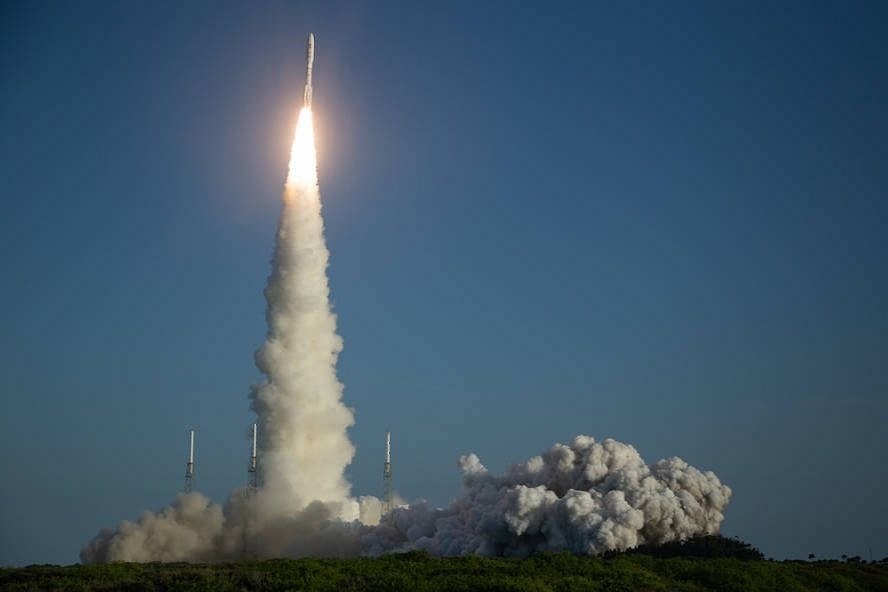News Brief
NASA Launches Mars Perseverance Rover To Search For Signs Of Ancient Life On The Red Planet

NASA's Mars Perseverance Rover was launched Thursday onboard Atlas V rocket
NASA on Thursday (30 July) launched the Mars 2020 Perseverance rover that will seek, as a primary goal, to answer one of the key questions of astrobiology: Are there potential signs of past microbial life, or biosignatures on the Red Planet?
Launched on a United Launch Alliance Atlas V rocket from Space Launch Complex 41 at Cape Canaveral Air Force Station in Florida, the rover will also test new technologies to benefit future robotic and human exploration of Mars.
"Today's final critical milestone - acquisition of signal - has been achieved. In essence, Perseverance has phoned home to let us know it's officially on the way to Mars," the US space agency said in a statement.
The rover will land at Mars' Jezero Crater on 18 February 2021.
"This signifies that JPL's (NASA's Jet Propulsion Laboratory) deep space network has locked on to the spacecraft, which is on its journey to Mars," said NASA Launch Manager Omar Baez, from the agency's Launch Services Programme.
"Everything appears to be going nominally. Today's count went beautifully."
The mission -- designed to better understand the geology and climate of Mars and seek signs of ancient life on the Red Planet -- will use the robotic scientist, which weighs just under 1,043 kgs and is the size of a small car, to collect and store a set of rock and soil samples that could be returned to Earth by future Mars sample return missions.
Perseverance will also ferry a separate technology experiment to the surface of Mars -- a helicopter named Ingenuity, the first aircraft to fly in a controlled way on another planet.
"With the launch of Perseverance, we begin another historic mission of exploration," said NASA Administrator Jim Bridenstine.
"This amazing explorer's journey has already required the very best from all of us to get it to launch through these challenging times. Now we can look forward to its incredible science and to bringing samples of Mars home even as we advance human missions to the Red Planet. As a mission, as an agency, and as a country, we will persevere," Bridenstine said.
NASA's Mars 2020 Perseverance is part of America's larger Moon to Mars exploration approach that includes missions to the Moon as a way to prepare for human exploration of the Red Planet.
NASA said its Perseverance rover builds on the lessons of other Mars rovers.
The Perseverance rover's astrobiology mission is to seek out signs of past microscopic life on Mars, explore the diverse geology of its landing site, Jezero Crater, and demonstrate key technologies that will help us prepare for future robotic and human exploration, the US space agency said.
The US space agency's first rover on Mars was modest: Sojourner, the size of a microwave oven, demonstrated in 1997 that a robot could rove on the Red Planet.
NASA's next Mars rovers, Spirit and Opportunity, were each the size of a golf cart. After landing in 2004, they discovered evidence that the planet once hosted running water before becoming a frozen desert.
The car-sized Curiosity rover landed in 2012. Curiosity discovered that its landing site, Gale Crater, hosted a lake billions of years ago and an environment that could have supported microbial life.
(With inputs from IANS)
Introducing ElectionsHQ + 50 Ground Reports Project
The 2024 elections might seem easy to guess, but there are some important questions that shouldn't be missed.
Do freebies still sway voters? Do people prioritise infrastructure when voting? How will Punjab vote?
The answers to these questions provide great insights into where we, as a country, are headed in the years to come.
Swarajya is starting a project with an aim to do 50 solid ground stories and a smart commentary service on WhatsApp, a one-of-a-kind. We'd love your support during this election season.
Click below to contribute.
Latest